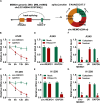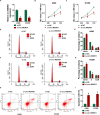Exosomal Circ-MEMO1 Promotes the Progression and Aerobic Glycolysis of Non-small Cell Lung Cancer Through Targeting MiR-101-3p/KRAS Axis
- PMID: 33005174
- PMCID: PMC7483554
- DOI: 10.3389/fgene.2020.00962
Exosomal Circ-MEMO1 Promotes the Progression and Aerobic Glycolysis of Non-small Cell Lung Cancer Through Targeting MiR-101-3p/KRAS Axis
Abstract
Circular RNA mediator of cell motility 1 (circ-MEMO1) was identified as an oncogene in non-small cell lung cancer (NSCLC). Nevertheless, the working mechanism behind circ-MEMO1-mediated progression of NSCLC is barely known. Quantitative real-time polymerase chain reaction (qRT-PCR) was applied to detect the expression of circ-MEMO1, microRNA-101-3p (miR-101-3p), and KRAS proto-oncogene, GTPase (KRAS). Cell proliferation and aerobic glycolysis were detected by 3-(4,5-Dimethylthiazol-2-yl)-2,5-diphenyltetrazolium bromide (MTT) assay and glycolysis detection kits. Flow cytometry was used to evaluate cell cycle progression and apoptosis of NSCLC cells. Western blot assay was used to measure the protein expression of hexokinase 2 (HK2), lactate dehydrogenase A (LDHA), KRAS, CD9, CD81, tumor susceptibility 101 (TSG101), and Golgi matrix protein 130 kDa (GM130). The target relationship between miR-101-3p and circ-MEMO1 or KRAS was predicted by StarBase software and confirmed by dual-luciferase reporter assay, RNA immunoprecipitation (RIP) assay, and RNA-pull down assay. In vivo tumor growth assay was conducted to assess the effect of circ-MEMO1 in vivo. Exosomes were isolated using the ExoQuick precipitation kit. Circ-MEMO1 was up-regulated in NSCLC, and high expression of circ-MEMO1 predicted poor prognosis in NSCLC patients. Circ-MEMO1 accelerated the proliferation, cell cycle progression, and glycolytic metabolism and inhibited the apoptosis of NSCLC cells. Circ-MEMO1 negatively regulated the expression of miR-101-3p through direct interaction, and si-circ-MEMO1-induced biological effects were attenuated by the introduction of anti-miR-101-3p. MiR-101-3p directly interacted with the 3' untranslated region (3' UTR) of KRAS messenger RNA (mRNA), and KRAS level was regulated by circ-MEMO1/miR-101-3p axis. Circ-MEMO1 silencing suppressed the NSCLC tumor growth in vivo. ROC curve analysis revealed that high expression of serum exosomal circ-MEMO1 (exo-circ-MEMO1) might be a valuable diagnostic marker for NSCLC. Circ-MEMO1 facilitated the progression and glycolysis of NSCLC through regulating miR-101-3p/KRAS axis.
Keywords: KRAS; NSCLC; circ-MEMO1; exosome; glycolysis; miR-101-3p.
Copyright © 2020 Ding, Xi, Wang, Cui, Zhang, Wang, Jiang, Song, Xu and Wang.
Figures









Similar articles
-
Circ-ZNF609 Accelerates the Radioresistance of Prostate Cancer Cells by Promoting the Glycolytic Metabolism Through miR-501-3p/HK2 Axis.Cancer Manag Res. 2020 Aug 20;12:7487-7499. doi: 10.2147/CMAR.S257441. eCollection 2020. Cancer Manag Res. 2020. PMID: 32943916 Free PMC article.
-
Serum Exosomes-Based Biomarker circ_0008928 Regulates Cisplatin Sensitivity, Tumor Progression, and Glycolysis Metabolism by miR-488/HK2 Axis in Cisplatin-Resistant Nonsmall Cell Lung Carcinoma.Cancer Biother Radiopharm. 2023 Oct;38(8):558-571. doi: 10.1089/cbr.2020.4490. Epub 2021 Mar 3. Cancer Biother Radiopharm. 2023. PMID: 33661058
-
Anesthetic propofol suppresses growth and metastasis of lung adenocarcinoma in vitro through downregulating circ-MEMO1-miR-485-3p-NEK4 ceRNA axis.Histol Histopathol. 2022 Dec;37(12):1213-1226. doi: 10.14670/HH-18-465. Epub 2022 May 6. Histol Histopathol. 2022. PMID: 35521898
-
Exosomal Circ-ZNF652 Promotes Cell Proliferation, Migration, Invasion and Glycolysis in Hepatocellular Carcinoma via miR-29a-3p/GUCD1 Axis.Cancer Manag Res. 2020 Aug 24;12:7739-7751. doi: 10.2147/CMAR.S259424. eCollection 2020. Cancer Manag Res. 2020. PMID: 32943922 Free PMC article.
-
Emerging role of non-coding RNAs in the regulation of KRAS.Cancer Cell Int. 2022 Feb 9;22(1):68. doi: 10.1186/s12935-022-02486-1. Cancer Cell Int. 2022. PMID: 35139853 Free PMC article. Review.
Cited by
-
KIFC1 promotes aerobic glycolysis in endometrial cancer cells by regulating the c-myc pathway.J Bioenerg Biomembr. 2021 Dec;53(6):703-713. doi: 10.1007/s10863-021-09924-1. Epub 2021 Nov 3. J Bioenerg Biomembr. 2021. PMID: 34729671
-
Circular RNA hsa_circ_0006117 Facilitates Pancreatic Cancer Progression by Regulating the miR-96-5p/KRAS/MAPK Signaling Pathway.J Oncol. 2021 Sep 2;2021:9213205. doi: 10.1155/2021/9213205. eCollection 2021. J Oncol. 2021. PMID: 34512755 Free PMC article.
-
Functional prediction and profiling of exosomal circRNAs derived from seminal plasma for the diagnosis and treatment of oligoasthenospermia.Exp Ther Med. 2022 Sep 2;24(5):649. doi: 10.3892/etm.2022.11586. eCollection 2022 Nov. Exp Ther Med. 2022. PMID: 36168415 Free PMC article.
-
Role of circular RNAs in the diagnosis, regulation of drug resistance and prognosis of lung cancer.Oncol Lett. 2022 Jul 7;24(3):302. doi: 10.3892/ol.2022.13422. eCollection 2022 Sep. Oncol Lett. 2022. PMID: 35949591 Free PMC article. Review.
-
MiR-485-3p/MiR-543/MiR-337-3p is Required for the Oncogenic Potential of the Hsa_circ_0007385-MEMO1 Axis in Colorectal Cancer.Biochem Genet. 2024 Apr;62(2):1182-1199. doi: 10.1007/s10528-023-10472-z. Epub 2023 Aug 10. Biochem Genet. 2024. PMID: 37561333
References
-
- Cui Y., Zhang F., Zhu C., Geng L., Tian T., Liu H. (2017). Upregulated lncRNA SNHG1 contributes to progression of non-small cell lung cancer through inhibition of miR-101-3p and activation of Wnt/beta-catenin signaling pathway. Oncotarget 8 17785–17794. 10.18632/oncotarget.14854 - DOI - PMC - PubMed
LinkOut - more resources
Full Text Sources
Miscellaneous

